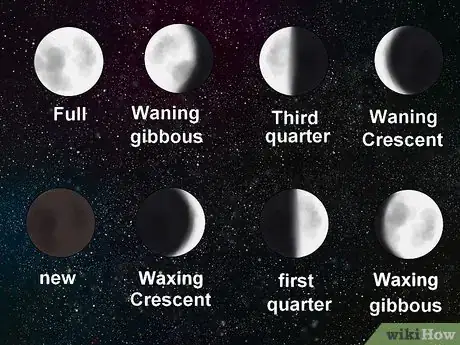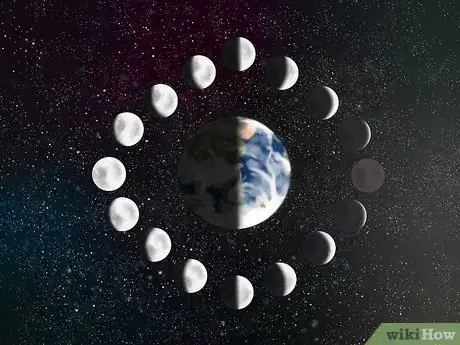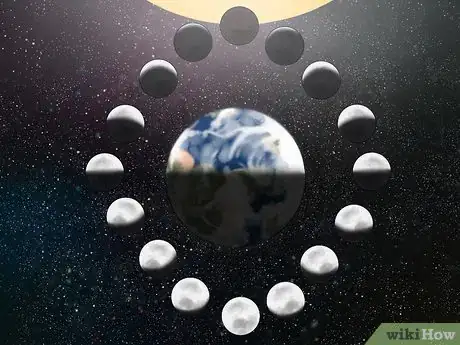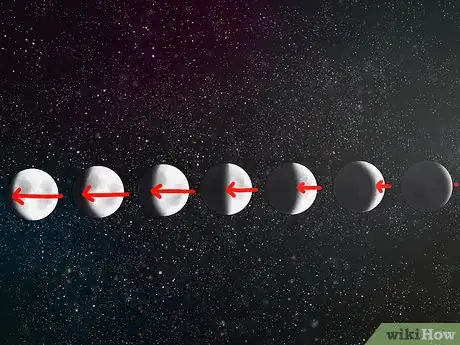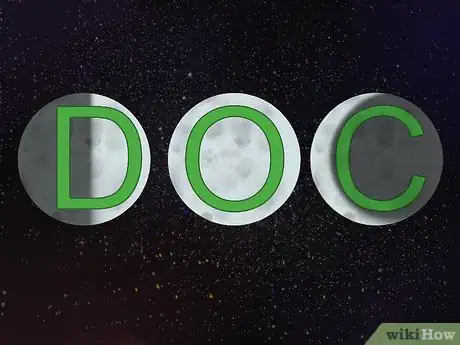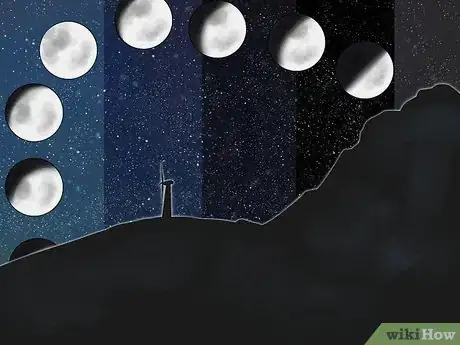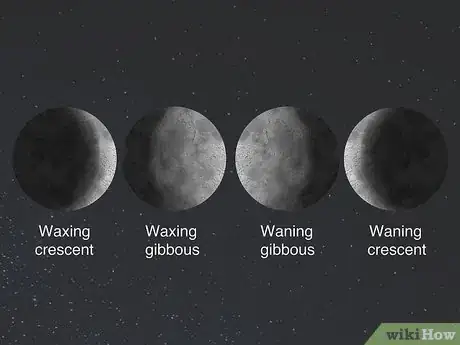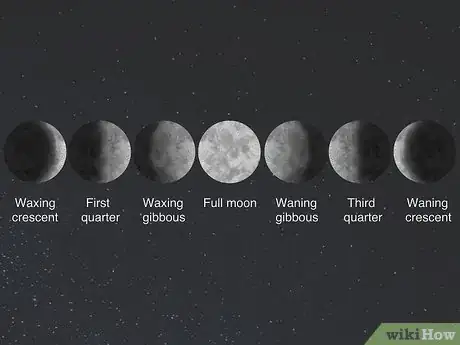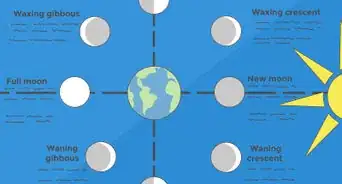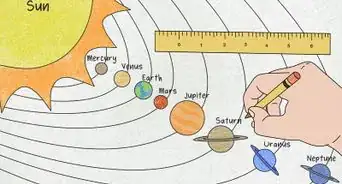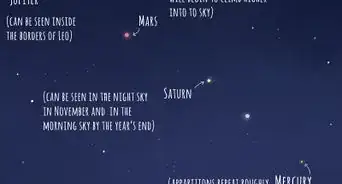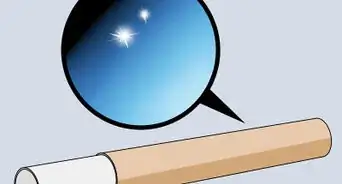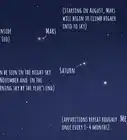This article was co-authored by wikiHow Staff. Our trained team of editors and researchers validate articles for accuracy and comprehensiveness. wikiHow's Content Management Team carefully monitors the work from our editorial staff to ensure that each article is backed by trusted research and meets our high quality standards.
wikiHow marks an article as reader-approved once it receives enough positive feedback. This article received 24 testimonials and 83% of readers who voted found it helpful, earning it our reader-approved status.
This article has been viewed 1,218,476 times.
Learn more...
The moon takes 27.3 days to orbit the earth, but the full lunar cycle takes a full 29.5 days to complete. Throughout the cycle, the moon will be waxing each day, or increasing how much of it you can see lit up at night, then waning, or decreasing in size until it disappears. Wherever it is in the cycle, there are key clues hidden in the moon’s shape that can help indicate whether it is in the waxing or waning process. This can in turn give you information about the moon’s phase, the tides, and where the moon is in relation to the Earth and the sun. Whether you’re hoping to see the moon in a certain phase, or meet the man on the moon, knowing whether the moon is waxing or waning is easy with some simple astronomical tricks!
Steps
Understanding the Phases of the Moon
-
1Learn the names of the phases. The moon revolves around the Earth, and as it does, we see different angles of the moon’s illuminated surface. The moon doesn’t create its own light, but rather shines when it reflects the sun’s light. [1] As the moon transitions from new to full and back to new again, it goes through several phases, marked by its recognizable crescent and gibbous ("bulging") shapes, which are created by the moon’s own shadow.[2] The moon phases are:
-
2Learn what the phases mean. The moon travels the same path around the Earth every month, so it goes through the same monthly phases. The phases exist because from our perspective on Earth, we observe the illuminated portion of the moon differently as it makes its way around us. Remember that half the moon is always illuminated by the sun: it’s our vantage point on Earth that changes and determines what phase we see.[4]
- During the new moon, the moon is between the Earth and the sun, and is therefore not illuminated at all from our perspective. At this time, the moon’s illuminated side completely faces the sun, and we see the side that’s in full shadow.
- During the first quarter, we see half of the moon’s illuminated side and half of the moon’s shadowed side. The same is true in the third quarter, except the sides we see are reversed.[5]
- When the moon appears full, we see its full illuminated half, while the side that’s in complete shadow faces out into space.
- After the full moon, the moon continues its journey back to its original position between the Earth and the sun, which is another new moon.
- It takes the moon a little over 27.32 days to complete one full revolution around the Earth. However, a full lunar month (from new moon to new moon) is 29.5 days, because that’s how long it takes the moon to return to its position between the sun and Earth.[6]
Advertisement -
3Learn why the moon waxes and wanes. On the moon’s journey from new moon to full moon, we see a growing portion of its illuminated half, and this is called the waxing phase (waxing means growing or increasing). As the moon then goes from full to new again, we see a diminishing portion of its illuminated half, and this is called waning, which means decreasing in strength or intensity.
- The moon’s phases always look the same, so although the moon itself may appear in different locations and orientations in the sky, you’ll always be able to identify what phase it’s in if you know what to look for.
Determining Moon Phases in the Northern Hemisphere
-
1Recognize that the moon waxes and wanes from right to left. Different parts of the moon are illuminated during waxing and waning. In the Northern Hemisphere, the part of the moon that is illuminated will appear to grow from right to left until it’s full, and it will then diminish from right to left.
- A waxing moon will be illuminated on the right side, and a waning moon will be illuminated on the left side.[7]
- Hold out your right hand with your thumb out, palm facing the sky. The thumb and forefingers make a curve like a backward C. If the moon fits in this curve, it's a waxing moon (increasing). If you do the same with your left hand and the moon fits in the "C" curve then it is waning (decreasing).
-
2Remember D, O, C. Since the moon always follows the same illumination pattern, you can use the shape of the letters D, O, and C to determine if the moon is waxing or waning. During the first quarter, the moon will look like a D. When it’s full, it will look like an O. And when it’s in the third quarter, it will look like a C.
- A crescent moon in the shape of a backwards C is waxing
- A half or gibbous moon in the shape of a D is waxing.
- A half or gibbous moon in the shape of a backwards D is waning.
- A crescent moon in the shape of a C is waning.
-
3Learn when the moon rises and sets. The moon doesn’t always rise and set at the same time, but changes depending on what phase it’s in. This means you can use the time of moonrise and moonset to determine if the moon is waxing or waning.
- You can’t see a new moon because it isn’t illuminated by the sun, and because it rises and sets at the same time as the sun.
- As the waxing moon moves into its first quarter, it will rise in the morning, reach its height around dusk, and set around midnight.
- Full moons come up when the sun goes down and set when the sun comes up.
- As the waning moon moves into its third quarter, it will rise at midnight and set in the morning.[8]
Determining Moon Phases in the Southern Hemisphere
-
1Learn which part of the moon is illuminated during waxing and waning. In opposition to the moon in the Northern Hemisphere, the moon in the Southern Hemisphere will illuminate from left to right, become full, and then diminish from left to right.
- A moon that’s illuminated on the left side is waxing, while a moon that’s illuminated on the right side is waning.[9]
- Hold out your right hand with your thumb out, palm facing the sky. The thumb and forefingers make a curve like a backward C. If the moon fits in this curve, it's a waning moon (decreasing). If you do the same with your left hand and the moon fits in the "C" curve then it is waxing (increasing).
-
2Remember C, O, D. The moon goes through all the same phases in the Southern Hemisphere, but the shapes of the letters that indicate waxing and waning are reversed from the Northern Hemisphere.
- A crescent moon in the shape of a C is waxing
- A half or gibbous moon in the shape of a backwards D is waxing.
- A moon in the shape of an O is full.
- A half or gibbous moon in the shape of a D is waning.
- A crescent moon in the shape of a backwards C is waning.
-
3Learn when the moon rises and sets. Although the moon may illuminate in the opposite direction in the Southern Hemisphere versus the Northern, it will still rise and set at the same times during the same phases.
- The first-quarter moon will rise in the morning and set around midnight.
- The full moon rises and sets when the sun sets and rises.
- The third-quarter moon will rise at midnight and set in the morning.[10]
Community Q&A
-
QuestionWhy is the moon sometimes visible in the daytime?
 wikiHow Staff EditorThis answer was written by one of our trained team of researchers who validated it for accuracy and comprehensiveness.
wikiHow Staff EditorThis answer was written by one of our trained team of researchers who validated it for accuracy and comprehensiveness.
Staff Answer wikiHow Staff EditorStaff AnswerYou can’t see most celestial objects during the day because the sun’s light is too bright and overpowering. However, the moon is close enough to Earth to be visible during the day. The light of the sun helps illuminate it so it’s faintly visible during daylight hours.
wikiHow Staff EditorStaff AnswerYou can’t see most celestial objects during the day because the sun’s light is too bright and overpowering. However, the moon is close enough to Earth to be visible during the day. The light of the sun helps illuminate it so it’s faintly visible during daylight hours. -
QuestionCan a full moon have an impact on your mood?
 wikiHow Staff EditorThis answer was written by one of our trained team of researchers who validated it for accuracy and comprehensiveness.
wikiHow Staff EditorThis answer was written by one of our trained team of researchers who validated it for accuracy and comprehensiveness.
Staff Answer wikiHow Staff EditorStaff AnswerSome studies suggest that people may not sleep as well when the moon is full, which could potentially affect your mood. However, more research needs to be done on how the phases of the moon may affect mood and mental health.
wikiHow Staff EditorStaff AnswerSome studies suggest that people may not sleep as well when the moon is full, which could potentially affect your mood. However, more research needs to be done on how the phases of the moon may affect mood and mental health. -
QuestionWhat does a waxing or waning moon mean in astrology?
 wikiHow Staff EditorThis answer was written by one of our trained team of researchers who validated it for accuracy and comprehensiveness.
wikiHow Staff EditorThis answer was written by one of our trained team of researchers who validated it for accuracy and comprehensiveness.
Staff Answer wikiHow Staff EditorStaff AnswerIn Vedic (Hindu) astrology, a waxing moon represents the growth of new ideas and the start of new activities, while the waning moon represents the completion of activities as well as self-reflection and purification.
wikiHow Staff EditorStaff AnswerIn Vedic (Hindu) astrology, a waxing moon represents the growth of new ideas and the start of new activities, while the waning moon represents the completion of activities as well as self-reflection and purification.
References
- ↑ http://www.livescience.com/45979-why-does-the-moon-shine.html
- ↑ http://earthsky.org/moon-phases/waxing-crescent
- ↑ http://www.moonconnection.com/moon_phases.phtml
- ↑ http://www.moonconnection.com/moon_phases.phtml
- ↑ http://www.moonconnection.com/moon_phases.phtml
- ↑ http://www.primaryhomeworkhelp.co.uk/moon/facts.htm
- ↑ http://www.math.nus.edu.sg/aslaksen/teaching/moon.html
- ↑ http://www.primaryhomeworkhelp.co.uk/moon/facts.htm
- ↑ http://www.math.nus.edu.sg/aslaksen/teaching/moon.html
About This Article
To tell whether the moon is waxing or waning, you'll first need to factor in whether you live in the Northern or Southern Hemisphere, since the moon's phases don't look the same from both places. If you're in the Northern Hemisphere, the moon waxes and wanes from right to left, meaning a waxing moon is illuminated on the right side, and a waning moon is illuminated on the left side. In the Southern Hemisphere, it's the opposite—the moon waxes and wanes from left to right. To learn more about moon phases and what they mean, read on!
